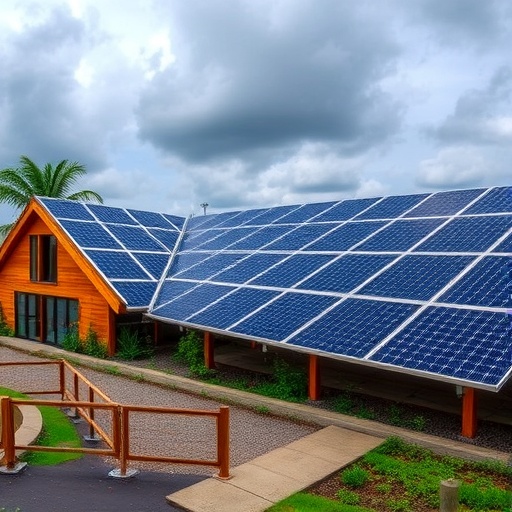
The Korea Institute of Materials Science (KIMS) has unveiled a groundbreaking development in solar technology that pushes the boundaries of efficiency and practicality for solar cell production. Led by key researchers Dr. Dong-chan Lim and Dr. So-yeon Kim, their team has successfully formulated a highly durable flexible perovskite solar cell that retains its stability in high humidity environments. This advancement is significant because it opens the doors to producing high-performance solar cells in normal atmospheric conditions, eliminating the traditional need for costly controlled environments during manufacturing.
Perovskite solar cells have captured the scientific community’s attention due to their remarkable qualities, such as exceptional light absorption, high flexibility, and low production costs. Until now, these benefits came at a steep price: the technology’s susceptibility to moisture and the requirement for low-humidity conditions or inert gas atmospheres has stymied its commercialization. The development of a more durable flexible perovskite solar cell represents a pivotal shift in overcoming these manufacturing obstacles, potentially leading to widespread adoption of this innovative technology across various applications.
The research team focused on enhancing the robustness of the perovskite material through a defect passivation strategy. By employing two-dimensional (2D) perovskite materials, they effectively encapsulated the light-absorbing layer at both its top and bottom. This ingenious approach not only improved the cells’ humidity resistance but also significantly augmented their mechanical stability. In practical terms, this means that the newly formed solar cells are able to perform steadily under humidity levels reaching 50%, a substantial improvement over previous iterations that would have faltered under similar conditions.
.adsslot_jPzQ2Ien0T{width:728px !important;height:90px !important;}
@media(max-width:1199px){ .adsslot_jPzQ2Ien0T{width:468px !important;height:60px !important;}
}
@media(max-width:767px){ .adsslot_jPzQ2Ien0T{width:320px !important;height:50px !important;}
}
ADVERTISEMENT
Notably, the endurance of these solar cells is nothing short of remarkable. Their efficiency remains above 85% even after 2,800 hours of operation — a testament to their durability. Additionally, the cells successfully maintained 96% of their efficiency after undergoing 10,000 bending cycles, validating their suitability for flexible applications. In more rigorous tests simulating extreme conditions, the solar cells preserved 87% of their operational efficiency, showcasing their capacity to withstand mechanical stress without significant degradation.
This technical breakthrough is significant not only for its immediate applications in solar technology but also for its potential impact on related industries. The ability to manufacture high-efficiency solar cells without complicated and expensive temperature and humidity management changes the game for solar manufacturing, ideally leading to lower production costs. As a result, the development aligns seamlessly with the growing demand for renewable energy solutions in a time where sustainability is paramount.
The research undertaken by KIMS is not only innovative but also scalable. The successful implementation of this production technology on a large scale suggests commercial viability, making it a more attractive option for manufacturers. This means that the opportunity for widespread deployment of rollable solar panels and other applications in lightweight, flexible electronics is on the horizon, significantly altering the landscape of renewable energy technology.
Dr. Dong-chan Lim expressed his enthusiasm for the potential of this technology, stating that it allows for the manufacturing of highly efficient perovskite solar cells in regular ambient air, doing away with the need for expensive manufacturing setups. This represents a significant leap towards achieving practical solar energy solutions that can be adapted for multiple use cases, including devices that integrate solar panels directly into clothing and vehicles.
The funding and collaborative efforts behind this research were not insignificant. Backed by the National Research Council of Science & Technology (NST), the National Research Foundation of Korea (NRF), and a cooperative project between Korea and Switzerland (SuraFlexi), the multidisciplinary nature of this project has emphasized the importance of international collaboration in scientific endeavors. Institutions such as the University of Fribourg and Pusan National University have played pivotal roles in making this research a reality.
As the study has been published in the highly esteemed Chemical Engineering Journal, it gains visibility among peers and industry leaders who may be inclined to further explore the implications of these findings. The groundwork laid by this research sets a precedent for future innovations in solar technology, propelling the industry towards better solutions that integrate sustainable practices while also meeting global energy needs.
Moreover, the research team plans to continue their work, aspiring to develop even more advanced solar cell materials that can withstand diverse environmental challenges, thus driving down production costs further. The team emphasizes the ongoing need for advancements in large-area processing technology to facilitate full commercialization of these solar solutions.
Each passing year deepens the urgency surrounding energy consumption and environmental sustainability. As global energy demands soar, innovations such as the highly durable flexible perovskite solar cells might not only provide efficient energy solutions but also serve as a catalyst for widespread adaptation and increased acceptance of renewable technologies. If successful, these endeavors will contribute significantly to the industrial growth necessary to transition to a more sustainable future.
As the world watches the developments emerge from the Korea Institute of Materials Science, the hope is that this breakthrough sparks further creativity and advances, raising the bar in solar manufacturing, energy efficiency, and environmental consciousness.
Subject of Research: Flexible Perovskite Solar Cells
Article Title: Air-processed flexible perovskite solar cells with superior mechanical reliability and humidity resistance enabled by stepwise interfacial engineering
News Publication Date: 31-May-2025
Web References: KIMS
References: Chemical Engineering Journal DOI
Image Credits: Korea Institute of Materials Science (KIMS)
Keywords
Perovskite, Solar Cells, Renewable Energy, Flexible Electronics, Manufacturing Cost Reduction, Humidity Resistance, Mechanical Durability, Sustainable Technology, KIMS, Breakthrough Innovation
Tags: advancements in renewable energyatmospheric stability in solar cellscommercialization of solar technologydefect passivation strategydurable solar cell materialsflexible perovskite solar cellshigh-performance solar cell productionhumidity resistant solar technologyinnovative solar energy solutionsKIMS solar research advancementslow-cost solar energy productionsolar energy breakthrough





